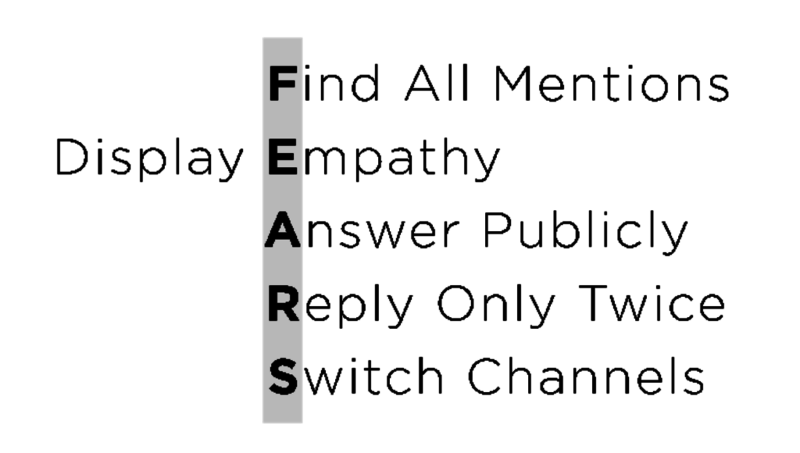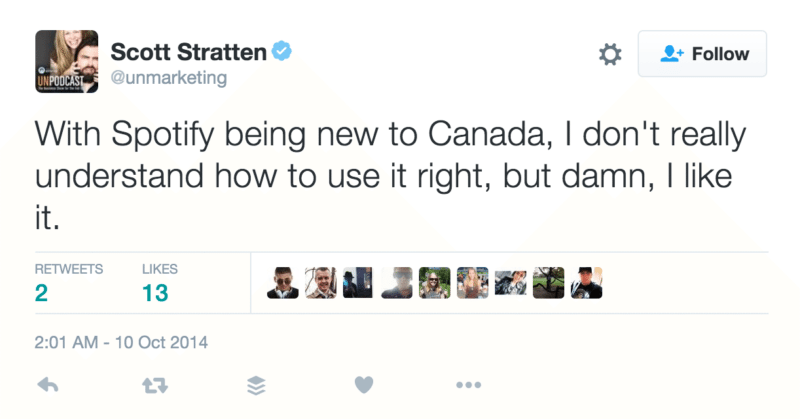
The 6 Step Playbook for Handling Social Media Complaints
Dealing with complainers and haters in social media can, of course, be tricky. What you need is a framework for how to do it right. This is that framework:
F-E-A-R-S:

You may notice that I didn’t include “be fast” as a specific component. This is because it is axiomatic.
Today, nearly 40% of all social media complainers who expect a response, expect that response to arrive within 60 minutes, according to the research I conducted for Hug Your Haters.
Yet, the average length of time for businesses to actually respond is five hours. Closing that gap is critical, and should be a focus for any legitimate social media customer service program.
In this post we’ll take a deep look at the F-E-A-R-S framework to help you deal with social media complaints.
Let’s go!

Find All Mentions
It’s impossible to hug the haters you never see.
In the legacy, offstage channels of phone and telephone, this isn’t an issue. If someone calls your business, you know they called. The phone was either answered or the caller left a message. The same is true for email; there’s no detective work needed to find them, they just show up on your computer, phone, or tablet.
But it’s harder with social media and other online customer complaints venues.
At the basic level, all companies should be using social media listening software. Large companies may employ specialized packages that also monitor review sites like Yelp, et al.
Software is a useful tool in the quest to find all customer feedback in social because much of that feedback doesn’t mention the company specifically.
Only about half of the people who complain in social expect to hear back from the company, so in many cases they do not phrase their complaints in a way that ties it back to the business in an obvious way. They don’t tag the business, for example.
Social customer service company Conversocial partnered with New York University on research that found that more than one-third of all tweets to companies were about customer service issues, but that only three percent incorporated the company’s Twitter username with the @ symbol.
This means that many mentions of your business online—on Twitter and beyond—may be indirect, which is why it’s crucial that you have a system that catches those complaints and comments.
Display Empathy
Though social media complainers and haters may not expect a reply, they definitely desire an audience. That’s why they raise the stakes and take grievances to a public forum. They want onlookers to chime in with variations on the theme of “I’m appalled! How dare they treat you this way!”
Their complaints are often filled with language that vacillates between colorful and outrageous. It creates the reaction they seek, from the audience and possibly from you. They are angry. They write something scathing and post it online. Now you’re angry too.
When you read a highly negative comment about your business (or about yourself), you not only feel angry but experience a very real physical reaction.
“As you become angry your body’s muscles tense up. Inside your brain, neurotransmitter chemicals known as catecholamines are released causing you to experience a burst of energy lasting up to several minutes. This burst of energy is behind the common angry desire to take immediate protective action. At the same time your heart rate accelerates, your blood pressure rises, and your rate of breathing increases. You’re now ready to fight.”
Accelerated heart rate. Increased blood pressure. Rapid breathing. These are not the ideal conditions for a speedy, empathetic response to customer complaints. But you have to find a way to keep your cool in the face of complaints, or find the people in your business who can do so.
Engaging in a sequence of acrimonious accusations with customers in a public, online forum never works. The business is never the perceived victor, even if they were truly in the right. Yet back-and-forth “flame wars” are not rare. They happen a lot, and they happen because the person answering customer complaints is unable to put empathy for the customer ahead of their physiological desire to fight.
Inserting empathy into your interactions with social media haters doesn’t mean that you give them all wet, sloppy kisses. It doesn’t mean you bend over backward. It doesn’t mean the customer is always right.
It does mean the customer is always heard, and you should acknowledge, instantly and often, that the person is having a problem that your business likely caused somehow. A short “I’m sorry” goes a long, long way.
A copy and paste, canned answer rarely conveys empathy. If your customer service personnel, especially online, have any responses in their quiver of standard answers that read like robotic, pasted copy, find them and start over. Because in some cases, scripted responses can come across as bad as no response at all.
Answer Publicly
Replying publicly is an important part of the playbook for handling social media complaints. Remember, online customer service is a spectator sport. Sure, you want to make the hater happy, but the opinions of the onlookers are the bigger prize.
Whether you’re in apology mode or responding to a positive comment, if your customer is choosing to interact with you in public, respond in the same way, at least at first. If you respond in private, you are squandering the trust capital gained by being open and transparent in how you handle customer feedback.
Tim Hansdorf is the co-founder of G2Crowd, a platform for ratings and reviews of B2B software, and he believes in the power of being public:
“I would start with being honest and transparent in all cases,” he says. “So if you make a mistake, I would admit to it and I would then focus on what you’re doing to handle it and why it wouldn’t occur again. I think transparency is the key. Transparency in my opinion is equal to trust and in today’s world of social media and what I call, “Everyone’s naked,” you’ve got to have it.”
You might think, “Well, who cares if they leave us a Yelp review and we reply back to them with a private message? At least we’re replying!” First, the spectators on Yelp don’t know you replied. Second, that kind of channel switching on the first response can be confusing for the customer.
Imagine if the equation was reversed. What if someone left you a voice mail, and you then tweeted them, “@Jaybaer Thanks for the voice mail. How can I help you?” That crosses the line from responsive to creepy.
Don’t be afraid of the technology limits of onstage channels, either. Indeed, it can seem like a restriction to only have 140 characters (for now) to respond on Twitter or to follow sometimes arcane guidelines when crafting a reply in a discussion board or forum.
This is where you can apply creativity to your responses, though. This is where the commitment to burning the script and empowering your customer service personnel to add empathy and humanity pays off in surprise and delight.
Here’s an example:
My friend Scott Stratten is a fantastic keynote speaker and author of many books, including QR Codes Kill Kittens. He’s a tech-savvy guy who spends an unhealthy amount of time on Twitter. Consequently, when the streaming music service Spotify launched in Canada (Scott lives outside Toronto), he complained on Twitter first.
In truth, his “complaint” was more of an observation. He posted:

(Notice that Scott mentioned Spotify, but didn’t specifically include the @Spotify or @SpotifyCares Twitter handles? That’s exactly what Conversocial’s research found to be the case, 97 percent of the time)
Spotify could have constrained themselves to Twitter’s 140-character limit and sent Scott a reply that said something like, “We’re sorry you’re having trouble. You can find our Frequently Asked Questions here: (insert link)” But they didn’t do that. They did so much more.
Spotify replied to Scott on Twitter and including an image capture of a custom music playlist they created just for him, where every song title fit together to form a coded message of support. They included a link to the custom playlist, as well. Here’s their response:
@unmarketing We’re here for you Scott, take a look at this: http://t.co/jmoEmx4GlG pic.twitter.com/j1RUK5hwyv
— SpotifyCares (@SpotifyCares) October 10, 2014
To which Scott tweeted back the only thing he could, really: “@SpotifyCares Now that’s awesome.”
The fact that Spotify put this together in 14 hours, at night (Scott tweeted at 9pm initially) is amazing. More amazing is that there is a song titled “And” in the Spotify library. (It’s by The Telescopes, if you’re interested).
Your customers aren’t always just curious and confused like Scott Stratten. Sometimes, they are downright angry. Or they might even be a troll.
Regardless of who the hater is, however, I recommend responding publicly. Even if they rant and rave and call you names, you’ll answer coolly and publicly. It probably won’t change the behavior or attitude of that one person, as it’s almost impossible to turn a crazy lemon into lemonade; the fruit is already rotten.
But by replying in public you show your temperament, your values, and your belief that all customers deserve to be heard.
Reply Only Twice
This is the question I get most often about the hug your haters system: “What if I respond to a hater, and he replies back with something even more negative?”
It happens all the time. Social media complainers see you respond and believe they have a foil, an opponent, a punching bag. But they do not. Because you and your customer service personnel know the key to effective onstage interactions: Jay Baer’s Rule of Reply Twice.
My Rule of Reply Twice is simple, and developed and proven across my 22 years as an online marketing and customer experience consultant.
The rule is: Online, never reply more than twice to any one person in any single conversation.
Violating the Rule of Reply Twice could drag you down into a vortex of negativity and hostility. Here’s how it works in practice. We’ll use a fictional hater called “Chad”:
Chad: “You guys are the absolute worst. I can’t believe you actually have the guts to accept American currency for your terrible product!”
Business: “We seem to have fallen short in your eyes, Chad. Can you tell me more about what happened, and I’ll do whatever I can to assist?”
Chad: “It won’t matter. It’s not like an idiot like you can fix all that’s wrong with this ridiculous company.”
Business: “I’m sorry you’re unhappy, and would like to help if possible. Please contact me via private message if you’d like me to give it a try.”
At this point, if Chad continues to complain, just let him do so. You’ve made two legitimate attempts to solve his problem. He has acknowledged this to be true by replying back to you, and the spectators will see the same. Now it’s time to let it go and walk away.
Nothing will be gained by replying again and again. You’ve done your part. You’re on record. Move on.
The Rule of Two does not dictate that you always have to answer twice, just that you never answer more than twice. One reply is sufficient for the majority of hater scenarios.
Ironically, even though customer interactions usually happen more quickly in onstage venues than offstage venues like email, it is important that you not respond instantly in social media, review sites, or forums. Quickly? Yes. Instantly? No. Instant replies are dangerous, as you can get caught up in the anger maelstrom respond in a manner that is less than optimal.
Switch Channels
The truncated nature of many social communications means it may be impossible to fully address a complex complaint in only two interactions.
Second, you may need the customers’ account number or other sensitive details to assist them, and you should not ask them to expose that information in full view of the digital spectators.
So for nuanced customer interactions that require research to resolve, your goal should be to switch channels after your initial, public response.
More than 60 percent of businesses say they are not capable of handling customer issues in one contact in social media. Many inquiries through these channels involve at least a second contact, in which the customer is sent to the telephone channel for resolution. This increases company costs, as they are adding a pricey telephone call on top of a comparatively inexpensive social media interaction. In this common scenario, customers who have chosen to complain in social are now forced to move offline.
For the tech-savvy customer segment (like Scott Stratten) that uses public channels not because they have been disappointed with legacy customer support, but because they simply prefer it (it’s their natural habitat), asking them to dial the phone to follow up on a tweet is like instructing them to churn their own butter to solve a problem with bland mashed potatoes.
A better method is that whenever you need to take a public, onstage customer interaction private, do so in the hidden chambers of the original contact channel.
Fortunately, almost all onstage channels offer this functionality to businesses. Take advantage of it.
If a hater reaches out to your business on Twitter and you need their account number to investigate, in your first reply apologize and ask them to send a direct message with their account number. Same thing with Facebook Messenger, Instagram, and beyond.
Some businesses switch from public to private channels and use the transition to build humanity and empathy.
Twitter, in particular, is a current leader in this opportunity as the platform has enabled businesses and consumers to create and send short videos instead of text and photos. You see Facebook urging more businesses to consider WhatsApp for similar circumstances. Interacting with haters through video can have a positive psychological effect, according to Michael Maoz from Gartner:
“When a customer looks at a customer support person on screen, their heart rate goes down, their blood pressure goes down, their euphoria goes up,” he explains. “Why? It’s really much more difficult to fail to be empathetic with a human being who is looking at you. The customer doesn’t have to be seen, but the fact that the customer support person is on screen, it’s a lot harder for me to be nasty in that situation.”
Channel switching in action
Jet Blue airlines will switch channels in a negative situation, and completely shock consumers as a result. It happened to Tom Webster, who directed the research we conducted for Hug Your Haters and wrote the foreword to this book.
Tom is a frequent Jet Blue flyer and knows how airplanes are supposed to sound and feel. Flying from Boston to Charlotte in an exit row seat next to the window, he heard an unusual grinding noise early in the flight, and noticed the fuselage becoming steadily warmer.
The aircraft was hot to the touch throughout most of the flight, and Webster was understandably concerned. Flight attendants were informed but were non-committal about what they would do about it, and couldn’t do much in the air anyway. Upon landing, Webster tweeted the airline and reported the incident.
This was more than two years ago, but Jet Blue’s Laurie Meacham, their manager of Customer Commitment, remembers Webster’s tweet.
“I do remember that, actually. And it’s a great example because it’s not like we did it just because of who he is,” Meacham recalls. “It is something that’s pretty typical of what we do with anybody. So obviously that’s a pretty big concern and that’s an issue, when the plane is so hot. And my team noticed it. They raised the flag, like, “Hey, this sounds concerning. What’s going on?” And from there it’s just a series of: who do we need to talk to? How can we find out what’s going on? Let’s close the loop. I know we involved a member of our Technical Operations team, to try to trouble-shoot the issue.”
Jet Blue didn’t just tweet Webster back or ask him to engage in a series of private, direct messages. Instead, they publicly tweeted that they would look into it. But then, they switched channels proactively. Within hours, Tom received an inbound telephone call, on his cellphone, from a senior Jet Blue operations representative.
“I was amazed,” he says. “Somehow they had seen my tweet and then figured out what flight I was on, as I didn’t mention it originally. Then they found my cell phone number. And then had someone call me personally. The coordination of all that is staggering to consider.”
Meacham explains how the detective work was accomplished:
“Even though his Twitter handle is pretty cryptic (@webby2001), the name “Tom Webster” is something we can search for in our system. We can find a reservation. If he has a TrueBlue account (the JetBlue frequent flier program), we can get his phone number from that, or we can get an email address.
Of course, first and foremost we wanted to reach out to him for his sake. But secondly, we were genuinely curious, like, what is going on and what other information do we need to fix this? And he might have some information that could help us as well.”
Evidently, Webster experienced an acute case of a longstanding issue: overheating of the control box that powers the live television available on all Jet Blue flights.
According to Meacham, all the old units have been replaced.
So there you have it, the playbook for handling social media complaints. Just remember F-E-A-R-S.

Try Buffer for free
140,000+ small businesses like yours use Buffer to build their brand on social media every month
Get started nowRelated Articles

Nobody wants to hear they’re outdated… stale… or old. That’s exactly what we had to face, though. Throughout the days, months, and years, our Help Center, where we keep up to date articles about Buffer for our customers, had become just that. Don’t get me wrong, there’s a ton of great content in there. That’s the problem, though. There’s just too much, and the content has started to become less and less reflective of Buffer: the product it is meant to support. There are four of us on the team w

This week, #bufferchat was all about how to keep your customers through awesome social media customer support. Jay Baer , author of Hug Your Haters and founder of Convince & Convert , stopped by the chat to share his strategies for providing top-notch social customer care! We discussed our top tips for responding to unhappy customers [https://buffer.com/resources/happy-customers-social-med

This week on #bufferchat, we were joined by one of Buffer’s Twitter Happiness Heroes, Darcy Peters , as our guest! We discussed the best tools and workflows for support teams , how to approach negative tweets, how to go the extra mile for customers , and more ! Catch our weekly Twitter chat